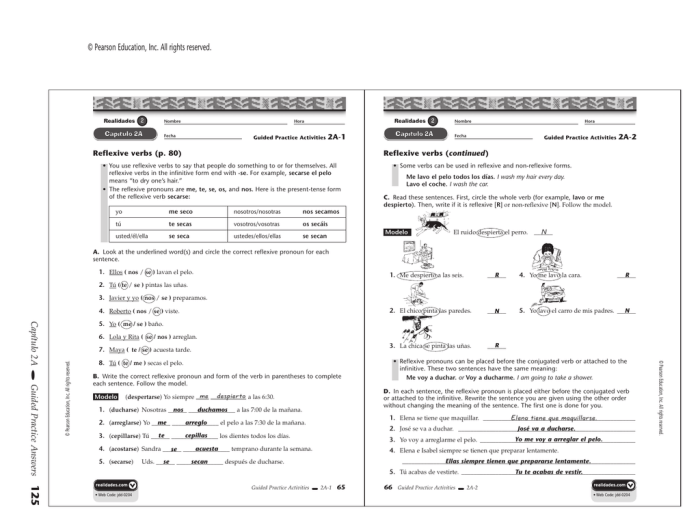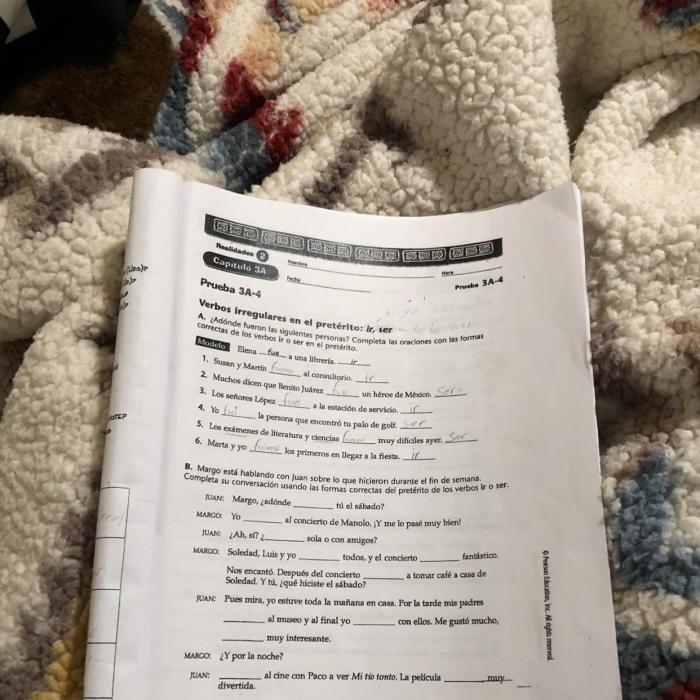Embark on a linguistic adventure with “Realidades 2 Capitulo 5B 2 Answers,” a comprehensive guide that illuminates the intricacies of the Spanish language and Hispanic culture. This meticulously crafted resource unravels the vocabulary, grammar, and cultural nuances of the chapter, empowering learners to master the complexities of Spanish communication.
Delve into the depths of vocabulary, where each word unveils a new facet of the language. Uncover the significance of grammar concepts, unlocking the secrets to sentence structure and fluency. Immerse yourself in the vibrant tapestry of Hispanic culture, gaining insights into customs, traditions, and perspectives.
Vocabulary: Realidades 2 Capitulo 5b 2 Answers

The vocabulary words in “Realidades 2 Capitulo 5B” are essential for understanding the chapter’s content. They include:
- Hablar– to speak
- Decir– to say
- Preguntar– to ask
- Responder– to answer
- Entender– to understand
- Saber– to know
- Poder– to be able to
- Querer– to want
- Gustar– to like
- Ir– to go
- Venir– to come
- Estar– to be
- Tener– to have
Grammar

“Realidades 2 Capitulo 5B” introduces several grammar concepts, including:
Present Tense of Regular Verbs
The present tense of regular verbs is formed by adding the following endings to the verb stem:
- -ar verbs: -o, -as, -a, -amos, -áis, -an
- -er verbs: -o, -es, -e, -emos, -éis, -en
- -ir verbs: -o, -es, -e, -imos, -ís, -en
For example, the present tense of hablar is hablo, hablas, habla, hablamos, habláis, and hablan.
Present Progressive
The present progressive is used to describe actions that are happening right now. It is formed by using the present tense of estar followed by the present participle of the main verb.
For example, the present progressive of hablar is estoy hablando, estás hablando, está hablando, estamos hablando, estáis hablando, and están hablando.
Direct Object Pronouns
Direct object pronouns are used to replace direct objects. They are placed before the conjugated verb.
- me – me
- te – you (familiar)
- lo – him, it (masculine)
- la – her, it (feminine)
- nos – us
- os – you (formal)
- los – them (masculine)
- las – them (feminine)
For example, the sentence “I speak Spanish” can be translated as “Hablo español” or “Lo hablo”.
Culture

“Realidades 2 Capitulo 5B” introduces several cultural aspects, including:
Spanish-Speaking Countries
The chapter discusses the different Spanish-speaking countries and their cultures. Students learn about the history, geography, and people of these countries.
Spanish Customs
The chapter also discusses some of the customs and traditions of Spanish-speaking countries. Students learn about the importance of family, food, and music in these cultures.
Spanish Cuisine, Realidades 2 capitulo 5b 2 answers
The chapter includes a section on Spanish cuisine. Students learn about the different types of food that are popular in Spanish-speaking countries.
Commonly Asked Questions
What is the significance of vocabulary in “Realidades 2 Capitulo 5B”?
Vocabulary forms the foundation of language comprehension. In “Realidades 2 Capitulo 5B,” each word holds a specific meaning, contributing to the overall understanding of the chapter’s content and cultural context.
How does grammar enhance language proficiency?
Grammar provides the framework for constructing meaningful sentences and communicating effectively. By understanding the grammar concepts introduced in “Realidades 2 Capitulo 5B,” learners gain the ability to express themselves accurately and fluently in Spanish.
What cultural insights can be gained from “Realidades 2 Capitulo 5B”?
The chapter immerses learners in the vibrant Hispanic culture, shedding light on customs, traditions, and perspectives. These cultural insights enhance comprehension of the language and foster a deeper appreciation for the richness of Spanish-speaking communities.